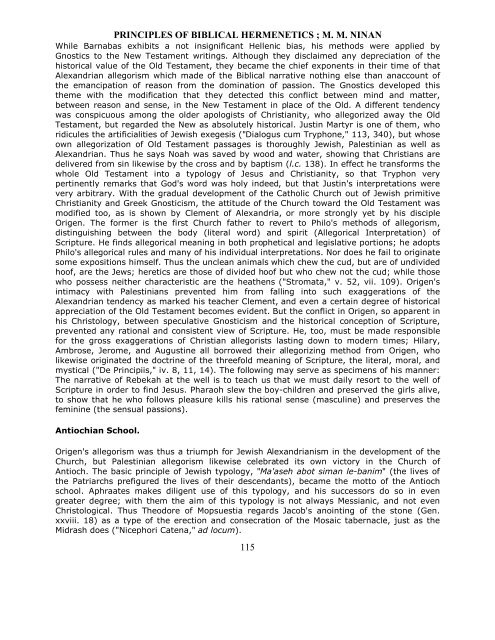Biblical Hermeneutics
You also want an ePaper? Increase the reach of your titles
YUMPU automatically turns print PDFs into web optimized ePapers that Google loves.
PRINCIPLES OF BIBLICAL HERMENETICS ; M. M. NINAN<br />
While Barnabas exhibits a not insignificant Hellenic bias, his methods were applied by<br />
Gnostics to the New Testament writings. Although they disclaimed any depreciation of the<br />
historical value of the Old Testament, they became the chief exponents in their time of that<br />
Alexandrian allegorism which made of the <strong>Biblical</strong> narrative nothing else than anaccount of<br />
the emancipation of reason from the domination of passion. The Gnostics developed this<br />
theme with the modification that they detected this conflict between mind and matter,<br />
between reason and sense, in the New Testament in place of the Old. A different tendency<br />
was conspicuous among the older apologists of Christianity, who allegorized away the Old<br />
Testament, but regarded the New as absolutely historical. Justin Martyr is one of them, who<br />
ridicules the artificialities of Jewish exegesis ("Dialogus cum Tryphone," 113, 340), but whose<br />
own allegorization of Old Testament passages is thoroughly Jewish, Palestinian as well as<br />
Alexandrian. Thus he says Noah was saved by wood and water, showing that Christians are<br />
delivered from sin likewise by the cross and by baptism (l.c. 138). In effect he transforms the<br />
whole Old Testament into a typology of Jesus and Christianity, so that Tryphon very<br />
pertinently remarks that God's word was holy indeed, but that Justin's interpretations were<br />
very arbitrary. With the gradual development of the Catholic Church out of Jewish primitive<br />
Christianity and Greek Gnosticism, the attitude of the Church toward the Old Testament was<br />
modified too, as is shown by Clement of Alexandria, or more strongly yet by his disciple<br />
Origen. The former is the first Church father to revert to Philo's methods of allegorism,<br />
distinguishing between the body (literal word) and spirit (Allegorical Interpretation) of<br />
Scripture. He finds allegorical meaning in both prophetical and legislative portions; he adopts<br />
Philo's allegorical rules and many of his individual interpretations. Nor does he fail to originate<br />
some expositions himself. Thus the unclean animals which chew the cud, but are of undivided<br />
hoof, are the Jews; heretics are those of divided hoof but who chew not the cud; while those<br />
who possess neither characteristic are the heathens ("Stromata," v. 52, vii. 109). Origen's<br />
intimacy with Palestinians prevented him from falling into such exaggerations of the<br />
Alexandrian tendency as marked his teacher Clement, and even a certain degree of historical<br />
appreciation of the Old Testament becomes evident. But the conflict in Origen, so apparent in<br />
his Christology, between speculative Gnosticism and the historical conception of Scripture,<br />
prevented any rational and consistent view of Scripture. He, too, must be made responsible<br />
for the gross exaggerations of Christian allegorists lasting down to modern times; Hilary,<br />
Ambrose, Jerome, and Augustine all borrowed their allegorizing method from Origen, who<br />
likewise originated the doctrine of the threefold meaning of Scripture, the literal, moral, and<br />
mystical ("De Principiis," iv. 8, 11, 14). The following may serve as specimens of his manner:<br />
The narrative of Rebekah at the well is to teach us that we must daily resort to the well of<br />
Scripture in order to find Jesus. Pharaoh slew the boy-children and preserved the girls alive,<br />
to show that he who follows pleasure kills his rational sense (masculine) and preserves the<br />
feminine (the sensual passions).<br />
Antiochian School.<br />
Origen's allegorism was thus a triumph for Jewish Alexandrianism in the development of the<br />
Church, but Palestinian allegorism likewise celebrated its own victory in the Church of<br />
Antioch. The basic principle of Jewish typology, "Ma'aseh abot siman le-banim" (the lives of<br />
the Patriarchs prefigured the lives of their descendants), became the motto of the Antioch<br />
school. Aphraates makes diligent use of this typology, and his successors do so in even<br />
greater degree; with them the aim of this typology is not always Messianic, and not even<br />
Christological. Thus Theodore of Mopsuestia regards Jacob's anointing of the stone (Gen.<br />
xxviii. 18) as a type of the erection and consecration of the Mosaic tabernacle, just as the<br />
Midrash does ("Nicephori Catena," ad locum).<br />
115


















